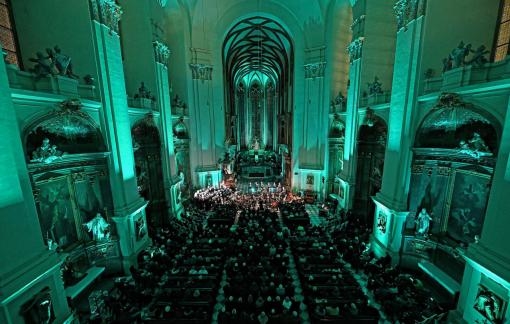Anyone who knows the B-Side Band, especially through performing international hit songs with the singer Vojtěch Dyk, or last year’s album Folk Swing, may be surprised by their unique take on a production of Jaromír Hnilička’s Missa Jazz. In fact, the big band’s history is tightly interwoven with the composer’s legendary Jazz Mass.
Before he became the founder and band leader of the B-Side Band, Josef Buchta wrote a diploma thesis on this musical piece. In 2008, after taking over the orchestra, he undertook a major tour of South Moravian towns and cities with this composition by Hnilička, establishing the Moravia Music Fest as a result, which has since transformed into the Groove Brno Festival. Josef Buchta also encouraged the Brno-based composer to revisit the piece in 2007, which had originally enjoyed success in Europe in the 1970s, extending it to encompass a chamber orchestra and writing a new choral section. While Jaromír Hnilička lived to see several concert performances of the updated work Missa Jazz, he did not get to hear it recorded in a studio, since this happened for the first time in COVID-wracked 2020, almost four years after the author had passed away. So it was that the B-Side Band, Komorní orchestr Brno (Chamber orchestra Brno) and Ars Brunensis chamber choir, under the baton of Dan Kalousek, gathered to make the recording.
Sessions took place with each section being recorded separately in two major studios in South Moravia: Tonstudio Rajchman in Dolní Bojanovice, which has a long history, and one at the Theatre on Orlí Street (Divadlo na Orlí) in Brno, a justifiably sought-out studio for jazz and other bands. The pandemic influenced the recording sessions in a both positive and negative aspects, because the musicians had the time, but as a respected instrumentalist in Brno put it: “I should have played too, but at that time I was concerned about the virus and decided not to take part”. The quality of the recording, however, remained intact despite the possible pitfalls of the erratic period. The technical standard and that of the performance is high, of which the various participants can be proud. It is worth noting that late Jaromír Hnilička was perfectly substituted as a soloist on trumpet and flugelhorn by Juraj Bartoš, while the leading parts for both the tenor and baritone saxes were rendered beautifully by Pavel Zlámal.
However, since a mass comprises music of a spiritual nature with a fixed structure and focus, the aim is not to overly distract listeners by the solo parts. In the Catholic (Latin) tradition, a mass refers to a joint celebration in which a priest and the congregation are participants. In this piece, these roles are taken on by the singers and musicians, respectively. In Hnilička’s composition this musical dimension of spirituality is fully developed, as evident in the respected, after the end of the legendary ten minutes section of Kyrie, with its alternating quiet and dynamic passages, followed by Gloria that brings together the choir and the exultant big band sound of brass instruments. It’s as if the words lifted from the Old Testament are directly interpreted through secular jazz instrumentation: “Make music to the Lord […] with the sound of singing, with the blare of the trumpets and the ram´s horn,” or, “praise him with timbrel and dancing, praise him with the strings and flute. A similar scheme, i.e. the set Latin ordinary of the mass, interspersed with bars performed by the big band (however minimalistic here), also appears in the short Sanctus section. The vocals in Pater Noster is followed by Interludium, a new part which highlights the orchestral strings. All of these feeds into the magnificent orchestral finale of Communio, with its slow build in intensity, followed by the celebratory Postludium.
A mass is a piece of music that can test the mettle of many an experienced composer. That Jaromír Hnilička is capable of this has been recognised for decades. The new production represents the new high in his musical achievements, combining the human voice, the big band, a rhythm section, a chamber orchestra with strings and other classical instruments such as the oboe, flute and harp, and all of it celebrates the Lord through the rich variety in tone on show, echoing the aforementioned passage from the Bible. Hnilička managed to lend nobility, desire, dynamism and mystery to his mass, where meditative passages lead to others replete with joy. Anyone who wished to could find faith, hope and love in his music. Although its spirituality and beauty can be enjoyed as a celebration of the transcendent, pleasure also comes through repeated listening, and its very accessibility means that some melodies are imminently hummable, despite its religiosity. Josef Buchta effectively serves as the catalyst for the piece, whereas the B-Side Band and the other musicians act as the conduit for the music, a feat of communal effort which should not be underestimated.
Jaromír Hnilička – Missa Jazz, as performed by the B-Side Band, Chamber orchestra Brno and Ars Brunensis chamber choir is released on Bujoart (2020). 13 tracks, total running time: 50:32
































No comment added yet..